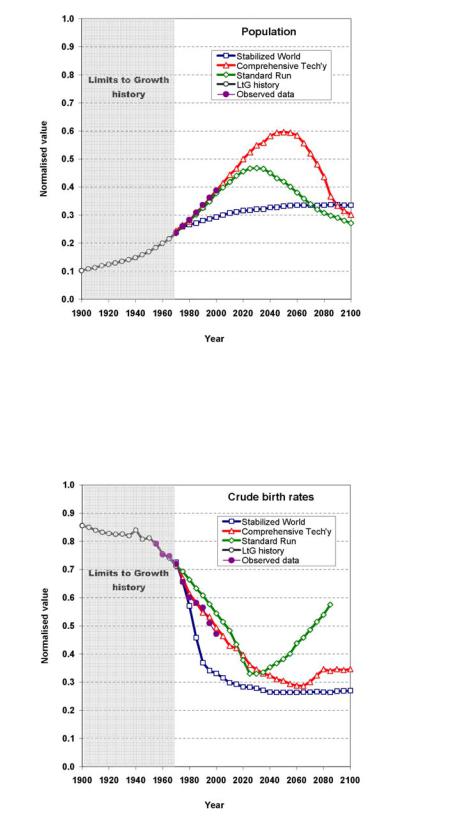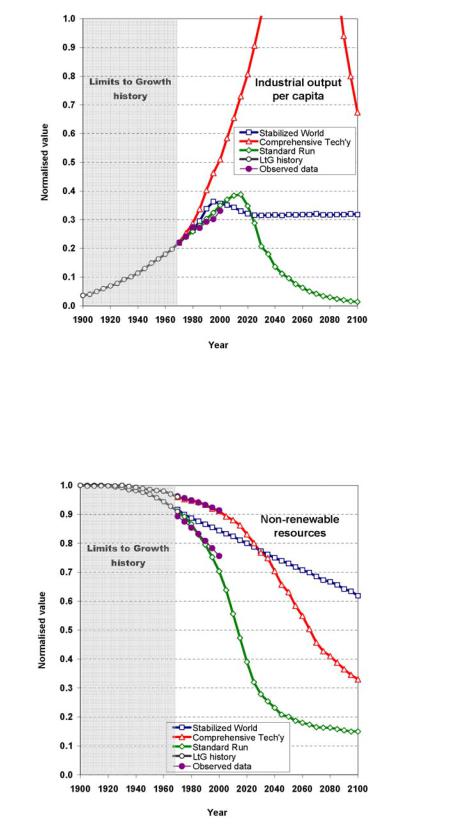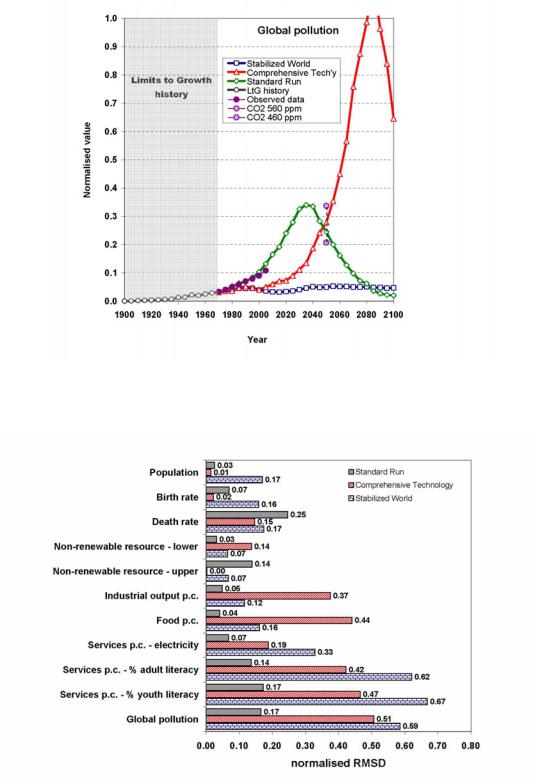
18-10-2014_18-18-15 / Turner
.pdfA Comparison of The Limits to Growth with Thirty Years of Reality
Global pollution has an important role in the LtG modeling, the scenario outcomes, and in this data comparison. Fortunately, uncertainty about the relationship between the level of pollution and ultimate impacts on ecological systems and human health is diminishing, particularly regarding greenhouse gases and climate change impacts.
In addition to the data-based corroboration presented here, contemporary issues such as peak oil, climate change, and food and water security resonate strongly with the feedback dynamics of “overshoot and collapse” displayed in the LtG
“standard run” scenario (and similar scenarios). Unless the LtG is invalidated by other scientific research, the data comparison presented here lends support to the conclusion from the LtG that the global system is on an unsustainable trajectory unless there is substantial and rapid reduction in consumptive behaviour, in combination with technological progress.
38
G. Turner
REFERENCES
Andersson, B.A. (2001) Department of Physical Resource Theory, Chalmers
University of Technology and Göteborg University, Göteborg.
Brown, L.R., Abramovitz, J.N., Assadourian, E., Dodson, J., Dunn, S., Flavin, C., French, H., Gardner, G., Halweil, B., Huvane, K., Hwang, A., Larsen, J.,
Lenssen, N., Mastny, L., McGinn, A.P., Nierenberg, D., Postel, S., Renner, M., Roodman, D.M., Sampat, P., Saoshiro, U., Scholand, M. and Sheehan, M.O.
(2002) Vital Signs 2002: The Trends That Are Shaping Our Future. New York: W.W. Norton and Company.
Cole, S. and Masini, E.B. (2001) Introduction - Limits beyond the millennium: a retro-prospective on The limits to growth. Futures 33: 1-5.
Costanza, R., Leemans, R., Boumans, R. and Gaddis, E. (2007) Integrated Global
Models. In Sustainability or Collapse? An Integrated History and Future of People on Earth. W. Steffen (ed.). Cambridge MA: MIT Press, 417-446.
Fargione, J., Hill, J., Tilman, D., Polasky, S. and Hawthorne, P. (2008) Land Clearing and the Biofuel Carbon Debt 10.1126/science.1152747. Science 319:
1235-1238.
Garnaut, R., Howes, S., Jotzo, F. and Sheehan, P. (2008, draft) Emissions in the Platinum Age: The Implications of Rapid Development for Climate Change Mitigation. Oxford Review of Economic Policy.
Grossman, G.M. and Helpman, E. (1991) Innovation and Growth in the Global
Economy, Cambridge MA and London UK: MIT Press.
Grübler, A. (1998) Technology and Global Change, Cambridge: Cambridge University Press.
Hansen, J. (2003) Can we defuse the global warming time bomb?
<http://naturalscience.com/ns/articles/01-16/ns_jeh.html>
Hardin, G. and Berry, R.S. (1972) Limits to Growth: Two Views. Bulletin of the Atomic Scientists 28: 22-27.
Herring, H. (2006) Energy efficiency-a critical view. Energy 31: 10-20.
Homer-Dixon, T. (2006) The Upside of Down-Catastrophe, Creativity and the
Renewal of Civilization. Washington: Island Press.
Huesemann, M.H. (2003) The limits of technological solutions to sustainable development. Clean Technologies and Environmental Policy 5: 21-34.
Interfutures (1979) Facing the future: mastering the probable and managing the unpredictable. Washington, D.C.: OECD (Organisation for Economic Cooperation and Development).
Jackson, J. and McIver, R. (2004) Macroeconomics. New York: McGraw Hill.
Jancovici, J.M. (2003) What was there in the famous Report to the Club of Rome?
<http://www.manicore.com/anglais/documentation_a/club_rome_a.html>
Jevons, W.S. (1865) The Coal Question; An Inquiry Concerning the Progress of the
Nation, and the Probable Exhaustion of Our Coal Mines. London: Macmillan and Co.
39
A Comparison of The Limits to Growth with Thirty Years of Reality
Khan, H., Brown, W. and Martel, L. (1976) The Next 200 Years. London: Abacus.
Ki-Moon, B. (2008) Opportunity in Crisis - Inaugural lecture of the Geneva Lecture Series. United Nations, Geneva (Switzerland).
<http://www.un.org/apps/news/story.asp?NewsID=26395&Cr=food&Cr1=crisis>
Lomborg, B. (2001) The Sceptical Environmentalist: Measuring the Real State of the World, Cambridge: Cambridge University Press.
Lowe, I. (2002) A Sustainable Debate. New Scientist 2369: 56.
McCabe, P.J. (1998) Energy Resources-Cornucopia or Empty Barrel? AAPG
Bulletin 82: 2110-2134.
McCutcheon, R. (1979) Limits of a Modern World: A Study of the Limits to Growth Debat. London: Butterworths.
Meadows, D.H., Meadows, D.L. and Randers, J. (1992) Beyond the Limits: Global Collapse or a Sustainable Future. London: Earthscan Publications Ltd.
Meadows, D.H., Meadows, D.L., Randers, J. and Behrens III, W.W. (1972) The Limits to Growth: a Report for the Club of Rome's Project on the Predicament of Mankind. New York: Universe Books.
Meadows, D.H., Randers, J. and Meadows, D.L. (2004) Limits to Growth: The 30-
Year Update. White River Junction, Vermont: Chelsea Green Publishing Co.
Meadows, D.L. (2007) Evaluating Past Forecasts: Reflections on One Critique of The Limits to Growth. In Sustainability or Collapse? An Integrated History and Future of People on Earth. R. Costanza, L. Grqumlich and W. Steffen (eds.).
Cambridge, MA: MIT Press, 399-415.
Meadows, D.L., Behrens III, W.W., Meadows, D.H., Naill, R.F., Randers, J. and Zahn, E.K.O. (1974) Dynamics of Growth in a Finite World. Massachusetts: Wright-Allen Press, Inc.
Moffatt, I., Hanley, N. and Wilson, M.D. (2001) Measuring and Modelling Sustainable Development. New York: The Parthenon Publishing Group.
Norton, J. (2003) A limitless myth. <http://info-pollution.com/limits.htm>
Passell, P., Roberts, M. and Ross, L. (1972) In New York Times Sunday Book Review.
Polimeni, J.M. and Polimeni, R.I. (2006) Jevons' Paradox and the myth of technological innovation. Ecological Complexity 3: 344-353.
Randers, J. (2000) From limits to growth to sustainable development or SD (sustainable development) in a SD (system dynamics) perspective. System
Dynamics Review 16.
Raupach, M.R., Marland, G., Ciais, P., Le Quere, C., Canadell, J.G., Klepper, G. and
Field, C.B. (2007) Global and regional drivers of accelerating CO2 emissions. Proceedings of the National Academy of Sciences (PNAS) of the United States of America 104: 10288–10293.
Ridley, M. (2001) Technology and the Environment: The Case for Optimism. Prince Philip Lecture delivered to the Royal Society of Arts, 8 March 2001 with HRH Prince Philip, Duke of Edinburgh, in the Chair
40
G. Turner
Rogner, H.H. (1997) An Assessment of World Hydrocarbon Resources. Annual.
Review of. Energy and the Enviroment 22: 217–262.
Sanera, M. and Shaw, J.S. (1996) Facts, Not Fear: Teaching Children about the
Environment. Washington, DC: Regnery Publications.
Sargent, R.G. (1998) Verification and Validation of Simulation Models. In Winter
Simulation Conference: Proceedings of the 30th Conference on Winter Simulation. D.J. Medeiros, E.F. Watson, J.F. Carson and M.S. Manivannan (eds.). Washington D.C.: IEEE Computer Society Press, 121-130.
Schneider, S.H. and Lane, J. (2006) An Overview of Dangerous Climate Change. In Avoiding Dangerous Climate Change. H.J. Schellnhuber, W. Cramer, N. Nakicenovic, T. Wigley and G. Yohe (eds.). Cambridge: Cambridge
University Press, 7-23.
Searchinger, T., Heimlich, R., Houghton, R.A., Dong, F., Elobeid, A., Fabiosa, J.,
Tokgoz, S., Hayes, D. and Yu, T-H. (2008) Use of U.S. Croplands for Biofuels Increases Greenhouse Gases Through Emissions from Land-Use Change 10.1126/science.1151861. Science 319: 1238-1240.
Simmons, M.R. (2000) Revisiting The Limits to Growth: Could The Club of Rome
Have Been Correct, After All? An Energy White Paper. <http://greatchange.org/ov-simmons,club_of_rome_revisted.html>
Solomon, S., Qin, D., Manning, M., Marquis, M., Averyt, K., Tignor, M.M.B., Miller, H. R. and Chin, Z. (eds.) (2007) IPCC Fourth Assessment Report of
Working Group 1: Climate Change 2007 - The Physical Science Basis.
Cambridge: Cambridge University Press.
Turner, G.M. (unpublished) A review of claims made against The Limits to Growth about its prediction of global collapse.
United Nations (2001a) Statistical Yearbook, Department of Economic and Social Affairs Statistical Division. New York: United Nations.
United Nations (2001b) World Population Monitoring 2001: Population, Environment and Development, Department of Economic and Social Affairs, Population
Division. New York: United Nations.
UN-Energy (2007) Sustainable Bioenergy: A Framework for Decision Makers. United Nations.
United Nations Energy Programme (UNEP) (2002) Global Environment Outlook 3: Past, Present and Future Perspectives. London: Earthscan Publications Ltd.
Wackernagel, M. and Rees, W.E. (1997) Perceptual and structural barriers to investing in natural capital: Economics from an ecological footprint perspective. Ecological Economics 20: 3-24.
Weitzman, M.L. (1992) Comments and Discussion (on Lethal Model 2: The Limits to Growth Revisisted by William D. Nordhaus. Brookings Papers on Economic
Activity 2: 50-54.
World Resources Institute (WRI) (2002) EarthTrends database. World Resources
Institute. <http://earthtrends.wri.org/>
41

A Comparison of The Limits to Growth with Thirty Years of Reality
Figure 1. Output from the LtG modelling for three scenarios ((a) standard run, (b) comprehensive technology, and (c) stabilized world) that effectively span the technological and social responses explored in the LtG
(a) Standard Run |
(b) Comprehensive Technology |
(c) Stabilised World |
42

G. Turner
Figure 2. Comparison of observed data (solid circles z) for global population with the LtG model output for each scenario (“standard run” with open diamonds , “comprehensive technology” with open triangles U, and “stabilized world” with open squares ). The calibrated model output over
1900–1970 is shown with open circles {
Figure 3. Comparison of observed data (solid circles z) for crude birth rates with the LtG model output for each scenario (“standard run” with open diamonds , “comprehensive technology” with open triangles U, and
“stabilized world” with open squares ). The calibrated model output over
1900–1970 is shown with open circles {
43

A Comparison of The Limits to Growth with Thirty Years of Reality
Figure 4. Comparison of observed data (solid circles z) for crude death rates with the LtG model output for each scenario (“standard run” with open diamonds , “comprehensive technology” with open triangles U, and “stabilized world” with open squares ). The calibrated model output over
1900–1970 is shown with open circles {
Figure 5. Observed (solid symbols) and World3 calculated (open symbols) “net” birth rates (the crude birth rate less the crude death rate)
44

G. Turner
Figure 6. Comparison of observed data (solid circles z) for services per capita
(upper: electricity; middle: adult literacy %; lower: youth literacy %) with the LtG model output for each scenario (“standard run” with open diamonds, “comprehensive technology” with open triangles U, and “stabilized world” with open squares ). The calibrated model output over 1900– 1970 is shown with open circles {
Figure 7. Comparison of observed data (solid circles z) for food per capita with the LtG model output for each scenario (“standard run” with open diamonds, “comprehensive technology” with open triangles U, and “stabilized world” with open squares ). The calibrated model output over 1900–
1970 is shown with open circles {
45

A Comparison of The Limits to Growth with Thirty Years of Reality
Figure 8. Comparison of observed data (solid circles z) for industrial output per capita with the LtG model output for each scenario (“standard run” with open diamonds , “comprehensive technology” with open triangles U, and “stabilized world” with open squares ). The calibrated model output over 1900–1970 is shown with open circles {
Figure 9. Comparison of observed data (solid circles z) for non-renewable resources remaining with the LtG model output for each scenario (“standard run” with open diamonds , “comprehensive technology” with open triangles U, and “stabilized world” with open squares ). The calibrated model output over 1900–1970 is shown with open circles {
46

G. Turner
Figure 10. Comparison of observed data (solid circles z) for global persistent pollution with the LtG model output for each scenario (“standard run” with open diamonds , “comprehensive technology” with open triangles U, and “stabilized world” with open squares ). The calibrated model output over 1900–1970 is shown with open circles {. Separate points at 2050 show IPCC estimates of possible upper and lower CO2 levels at 2050
(from A1F1 and B2 scenarios), corresponding to 560 and 460 ppm respectively
Figure 11. Normalised root mean square deviation for each LtG output compared with the observed data, for each scenario. Closer agreement between data and model output is indicated by smaller RMSD
47
